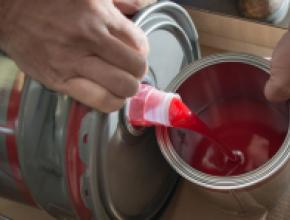Government and safety organizations, such as the U.S. Department of Transportation, don't mess around when it comes to labeling flammable liquids; many of us are familiar with the highly-visible red diamond, which encloses a flame and a number 3. That’s for a good reason – these liquids can be very volatile and dangerous.
According to the National Fire Protection Association (NFPA), between 2007-2011, fire departments in the U.S. responded to an annual average of 160,910 fires that were started by the ignition of flammable or combustible liquids. This resulted in an estimated 454 deaths and 3,910 injuries per year, as well as $1.5 billion in property damage.
These hazardous flammable liquids are commonplace in woodworking operations. Materials like petroleum or alcohol-based paints and coating, lacquers or mineral spirits, turpentine, methyl ethyl ketone and toluene are common items in shops for spray and finishing operations.
The NFPA defines flammable liquid as “any liquid that has a closed-cap flash point below 37.8C (100F).” Flammable liquids, unlike combustible liquids, do not need a direct heat source to catch fire.
These liquids can demonstrate different flammable properties. For example, some liquids can either mix with water or be deemed non-miscible, allowing these flammable liquids to lay on the water. Further, vapors from flammable liquids can burn quickly and fires can be difficult to put out. A foam and water mix may be necessary to extinguish a flammable liquid-induced fire in a woodshop.
Reduce risk
To reduce their exposure to fire when using flammable liquids, woodshop operators must incorporate specific fire safety best practices in their shops. One way to reduce the fire risk during spray finishing applications is to use a dedicated and UL Listed/FM Approved spray booth. When using a spray booth, woodshop operators should adhere to the NFPA 33: Standard for Spray Application Using Flammable or Combustible Materials, which includes the following:
• Ensure the spray booth is properly installed according to the manufacturer’s recommendations, made of metal and grounded for safety.
• Follow applicable electrical rules (NFPA 70, National Electric Code) that meet the specifications of the booth. For example, lighting might be required to be recessed outside the booth with vapor sealed and wired glass lenses.
• Make sure spray guns are interlocked with the booth ventilation system and that the ventilation system is made of non-ferrous metals or other non-sparking material.
• Remove the flammable vapors with an exhaust system. Follow NFPA 33 guidelines. The exhaust system should allow for a cross-sectional airflow of 100 feet per minute.
• Protect the booth with a sprinkler system or chemical fire suppression system.
• Clean the booth regularly and keep housekeeping records.
Storage is also a critical component when it comes to safety when working with flammable liquids. According to the NFPA, flammable liquids should be stored in UL-listed cabinets, or approved storage rooms in the case of flammable liquid quantities of more than 120 gallons. When using a storage room, woodworking operators should adhere to the following guidance:
• The room must be made of fire-resistant material, incorporate an open-grated trench outside or raised sills or ramps, and be outfitted with automatic closing doors.
• Electrical switches must be located outside the storage room and meet proper code requirements.
• The room must be outfitted with an approved exhaust system to provide airflow.
• Bulk items should be stored outdoors, away from the building and only secondly, in an indoor facility.
• The dispensing of flammable liquid must be grounded and bonded.
• A fire extinguisher should be kept near the door of the storage facility.
By incorporating a safety program for the usage and storage of flammable liquids, woodshops can reduce their risk of fire. To learn more, wood products manufacturers can partner with an insurer who specializes in wood risks and who could assist them in identifying the unique risk exposures of their shops, recommend risk mitigation strategies and provide insurance products that can be invaluable should the worst happen.
Source: Jeff Hendershot is Loss Control Manager at Pennsylvania Lumbermens Mutual Insurance Co. For information, visit plmins.com; Twitter: @PLMinsurance.






Have something to say? Share your thoughts with us in the comments below.